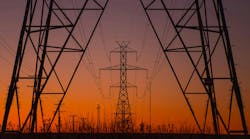The Department of Energy’s Office of Critical and Emerging Technologies is looking for ways to help deploy certain responsibilities under an October 30, 2023 executive order on the safe use of artificial intelligence.
DOE is expected to issue a public report within 180 days of the order describing the potential for AI to improve planning, permitting, investment and operations for electric grid infrastructure and to enable the provision of clean, affordable, reliable, resilient and secure electric power.
DOE will look for how AI can be developed and used by private actors, public-private partnerships, and government entities (at all levels of government, including federal, state, local, etc.) to improve the security and reliability of grid infrastructure and operations, as well as resilience of the grid to potential disruptions.
DOE is requesting comments on the use of AI in relation to the following topics:
Grid operations and reliability:
• Improvements in predictive maintenance for utilities;
• For rapid, accurate, and cost-effective load and supply balancing in light of increasing penetration of variable generation sources and increased opportunities for demand management through technologies such as electric vehicle charging/discharging, smart devices, or optimizing clean hydrogen production;
• To improve flexibility of power systems models or other interconnection software tools to facilitate more efficient processing of growing interconnection queues and handling distribution-side generation (such as rooftop solar) and increased demand from demand-side interconnection as, for example, transportation electrifies.
Grid Resilience:
• Characterization of impacts of climate hazards on electricity system infrastructure, connected to Climate Mapping for Resilience and Adaptation (CMRA) outputs;
• Opportunity for AI-enabled real-time self-healing infrastructure;
• Opportunity for AI-enabled detection and diagnosis of anomalous/malicious events;
• AI-enabled situational awareness and actions for resilience during and after a disruption.
DOE is seeking information on how AI can be used both by government entities at all levels of government (federal, state, local, etc.) as well as by private actors to improve the planning, siting, permitting, and investment in the grid and related clean energy infrastructure.
The following is a non-exhaustive list of topics expected to be addressed in comments on this topic:
• Opportunities for siting and permitting authorities to use AI (e.g., large language models, multi-modal generative, etc.) to improve and expedite their reviews;
• Actions federal agencies can take to support the effective deployment of generative AI tools to improve project planning, community engagement, and siting and permitting reviews (e.g., processing of existing government documents into AI- and ML-compatible data formats, clarification of standards around use of generative AI in preparation of submittals to government agencies, etc.);
• Steps federal agencies could take to improve compatibility of existing structured datasets (e.g., geospatial data on environmental resources, endangered species, environmental justice, historic and cultural resources, etc.) with emerging AI models and/or to utilize AI to revise and improve those existing datasets;
• Opportunities to use AI to validate and improve monitoring of existing projects (e.g., environmental mitigation monitoring, supply chain risks, and socio-economic impacts, etc.);
• Opportunities to use AI to illuminate and address artificial, arbitrary and unnecessary disproportionate impacts on disadvantaged communities from planning, permitting, or operation of energy infrastructure and to improve energy equity;
• Steps that should be taken to ensure transparency about any use of generative AI in government reviews and decision-making processes to avoid unlawful biases or discrimination in AI algorithms and datasets used.
DOE is seeking information regarding how AI can be used to strengthen the Nation's resilience against climate change, including opportunities to help predict, prepare for, and mitigate climate-driven risk. The following is a non-exhaustive list of topics that may be addressed in comments on this topic:
• Opportunities to use AI to forecast climate-driven extreme events (e.g., wildfires, flooding, hurricanes, etc.) and their impact on reliability and resilience requirements, as well as potential to use AI to mitigate climate-driven extreme event risks or otherwise bolster reliability and resilience;
• Opportunities to use AI to understand and forecast climate impacts on long-term future resource levels (compared to historical levels) and its effect on resource adequacy and availability;
• Opportunities to use AI to improve or accelerate numerical weather prediction models, particularly on time scales relevant to infrastructure planning and operations.
DOE is also seeking information about costs and ease of implementation for tools, systems, practices, and their benefits to public if adopted and utilized.


